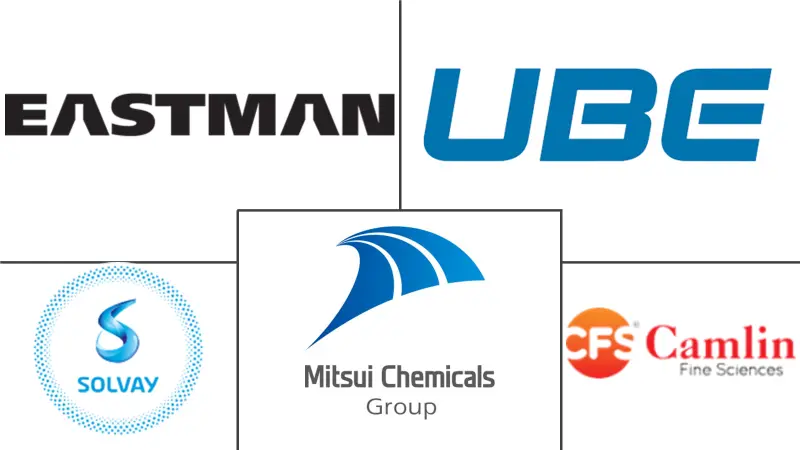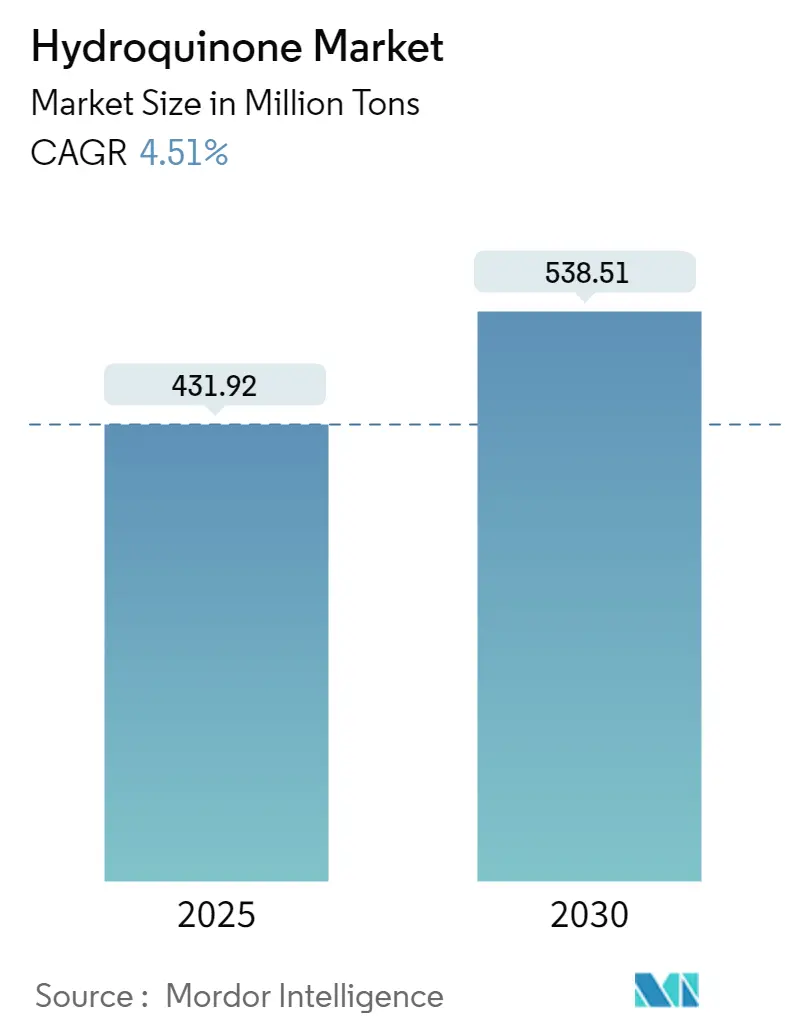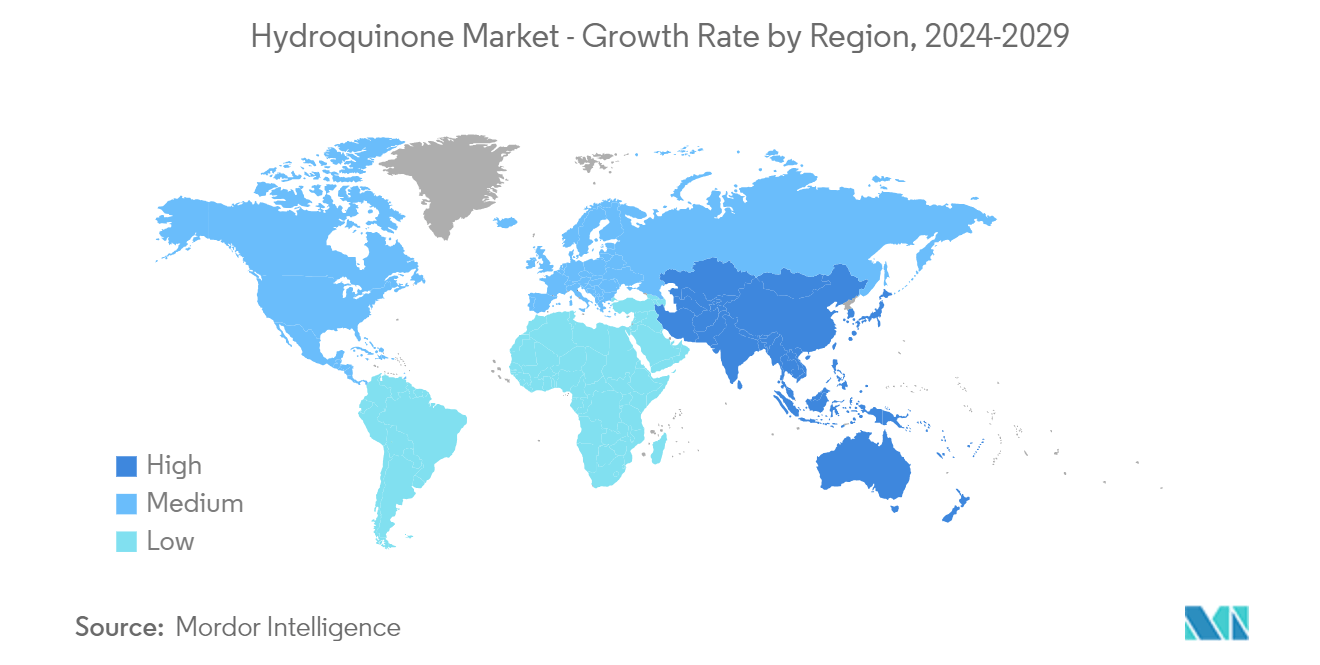Hydroquinone Market Analysis
The Hydroquinone Market size is estimated at 431.92 million tons in 2025, and is expected to reach 538.51 million tons by 2030, at a CAGR of 4.51% during the forecast period (2025-2030).
- The market is likely to be propelled by the growing demand from the rubber and paint manufacturing industry during the forecast period.
- On the other hand, the toxic and cancer-causing effects of skin creams are likely to slow the market's growth over the next few years.
- The prevalence of hydroquinone in the pharmaceutical sector is expected to grow considerably during the forecast period.
- Asia-Pacific dominated the market worldwide, with the largest consumption coming from countries such as China, India, and Japan.
Hydroquinone Market Trends
Increasing Demand from the Rubber Industry
- Reports from the Organisation for Economic Co-operation and Development indicate that approximately 25% of manufactured hydroquinone serves as an intermediate for synthesizing antioxidants and antiozonants in the rubber processing industry.
- As per the Association of Natural Rubber Producing Countries (ANRPC), global natural rubber production has been growing at an annual rate of 2.7%, culminating in a total of 14.916 million tons.
- ASEAN nations, prominently Thailand, Vietnam, and Myanmar, dominate rubber production and processing. For instance, in the first quarter of the 2024-2025 fiscal year, Myanmar exported over 62,000 tonnes of natural rubber, raking in over USD 87 million. As reported by ANRPC, the country aspires to surpass 300,000 tonnes by the fiscal year's end.
- Similarly, the All India Rubber Industry Association anticipates a 5% uptick in natural rubber production for 2023-2024, building on the previous fiscal year's output of 8 lakh metric tonnes.
- Annual tire production globally has been on a steady rise, driven by an expanding vehicle fleet. Emerging economies, particularly India and Brazil, have seen notable surges. In India, tire production for the financial year 2023 reached 217 million units, reflecting a 6% Y-o-Y growth, as per data from the Automotive Tyre Manufacturers’ Association (ATMA).
- Factors such as a demand for higher-performance tires, rising petroleum prices, stringent fuel efficiency mandates (like Euro 7 and NHTSA), and a transition toward electric vehicles are collectively boosting the demand for low-rolling resistance tires, suggesting a bullish market outlook.
- In 2023, tire manufacturers worldwide poured over USD 6.5 billion into new facilities, capacity expansions, and technological upgrades.
- Thus, the increasing trends in rubber production is expected to augment the demand for hydroquinone over the forecast period.
Asia-Pacific Region to Dominate the Market
- Countries like China, India, and Japan have driven Asia-Pacific to become the leading consumer of hydroquinone. Notably, the demand for hydroquinone is poised for significant growth in India and China.
- The region's expanding coatings production is set to be a key driver for the demand for hydroquinone, with a robust appetite for coating solutions attracting substantial investments in recent years.
- For example, in April 2024, Nipsea Group unveiled plans for a new automotive coatings manufacturing plant in Tianjin, China, backed by a USD 133 million investment. This move is strategically aimed at serving the rising needs of automotive OEM manufacturers.
- In a similar vein, Akzo Nobel NV wrapped up its powder coatings manufacturing facility in Bac Ninh province, close to Hanoi, Vietnam, in March 2024. This expansion underscores the company's intent to bolster its foothold in Asia and address the surging demand.
- Additionally, China, Japan, and South Korea stand out as significant consumers of cosmetic products. According to the National Bureau of Statistics of China, the cosmetics sector has seen rapid growth over the past decade. In 2023, retail sales from wholesale and retail entities reached approximately CNY 414.17 billion (~USD 58 billion), marking a modest rise from the prior year.
- To further capitalize on this demand, numerous cosmetic expansion projects are underway. For instance, in September 2023, Cosmax, one of South Korea's leading cosmetics firms, inaugurated a new manufacturing facility in China, a venture realized through its collaboration with Yatsen Holding Limited.
- Given these developments and trends, Asia-Pacific is set to dominate the hydroquinone market in the coming years.
Hydroquinone Industry Overview
The hydroquinone market is consolidated by nature. Some major companies (not in a particular order) in the market include Solvay, UBE Corporation, Eastman Chemical Company, Mitsui Chemicals Inc., and Camlin Fine Sciences Ltd.
Hydroquinone Market Leaders
-
Solvay
-
Eastman Chemical Company
-
Mitsui Chemicals Inc.
-
Camlin Fine Sciences Ltd
-
UBE Corporation
- *Disclaimer: Major Players sorted in no particular order
Hydroquinone Market News
- February 2023: Solvay commenced the commercial production of its International Sustainability and Carbon Certification (ISCC) PLUS hydroquinone (HQ) product in Saint-Fons, France.
Hydroquinone Industry Segmentation
Hydroquinone is an aromatic compound manufactured during the synthesis of dyes, oils, motor fuels, etc. Hydroquinone is produced as an inhibitor, intermediate, and antioxidant during these processes. Quinol is another name for hydroquinone.
The hydroquinone market is segmented by application, end-user industry, and geography. By application, the market is segmented into intermediate, antioxidant, polymerization inhibitor, photosensitive chemical, and other applications. By end-user industry, the market is segmented into cosmetics, polymers, paints and adhesives, rubber, and other end-user industries. The report also covers the market size and forecasts for extruded polystyrene in 27 countries across major regions. For each segment, market sizing and forecasts were made based on volume (tons).
| By Application | Intermediate | ||
| Antioxidant | |||
| Polymerization Inhibitor | |||
| Photosensitive Chemical | |||
| Other Applications | |||
| By End-user Industry | Cosmetics | ||
| Polymers | |||
| Paints and Adhesives | |||
| Rubber | |||
| Other End-user Industries | |||
| By Geography | Asia-Pacific | China | |
| India | |||
| Japan | |||
| South Korea | |||
| Malaysia | |||
| Thailand | |||
| Indonesia | |||
| Vietnam | |||
| Rest of Asia-Pacific | |||
| North America | United States | ||
| Canada | |||
| Mexico | |||
| Rest of North America | |||
| Europe | Germany | ||
| United Kingdom | |||
| Italy | |||
| France | |||
| Russia | |||
| Spain | |||
| Turkey | |||
| Nordic Countries | |||
| Rest of Europe | |||
| South America | Brazil | ||
| Argentina | |||
| Colombia | |||
| Rest of South America | |||
| Middle East and Africa | Saudi Arabia | ||
| United Arab Emirates | |||
| Qatar | |||
| Egypt | |||
| Nigeria | |||
| South Africa | |||
| Rest of Middle-East and Africa | |||
Hydroquinone Market Research FAQs
How big is the Hydroquinone Market?
The Hydroquinone Market size is expected to reach 431.92 million tons in 2025 and grow at a CAGR of 4.51% to reach 538.51 million tons by 2030.
What is the current Hydroquinone Market size?
In 2025, the Hydroquinone Market size is expected to reach 431.92 million tons.
Who are the key players in Hydroquinone Market?
Solvay, Eastman Chemical Company, Mitsui Chemicals Inc., Camlin Fine Sciences Ltd and UBE Corporation are the major companies operating in the Hydroquinone Market.
Which is the fastest growing region in Hydroquinone Market?
Asia-Pacific is estimated to grow at the highest CAGR over the forecast period (2025-2030).
Which region has the biggest share in Hydroquinone Market?
In 2025, the Asia-Pacific accounts for the largest market share in Hydroquinone Market.
What years does this Hydroquinone Market cover, and what was the market size in 2024?
In 2024, the Hydroquinone Market size was estimated at 412.44 million tons. The report covers the Hydroquinone Market historical market size for years: 2019, 2020, 2021, 2022, 2023 and 2024. The report also forecasts the Hydroquinone Market size for years: 2025, 2026, 2027, 2028, 2029 and 2030.
Our Best Selling Reports
Hydroquinone Industry Report
Statistics for the 2025 Hydroquinone market share, size and revenue growth rate, created by Mordor Intelligence™ Industry Reports. Hydroquinone analysis includes a market forecast outlook for 2025 to 2030 and historical overview. Get a sample of this industry analysis as a free report PDF download.







